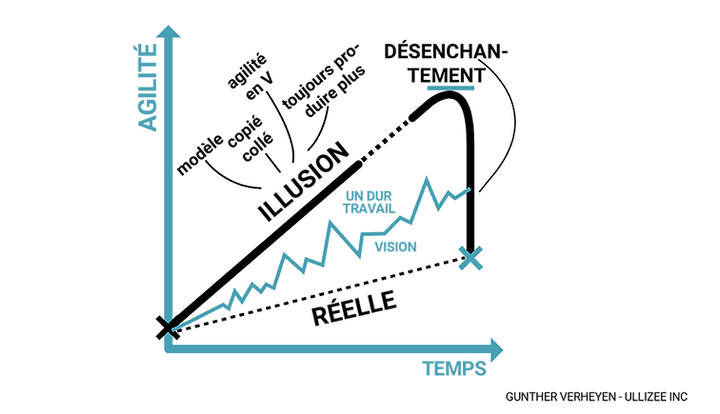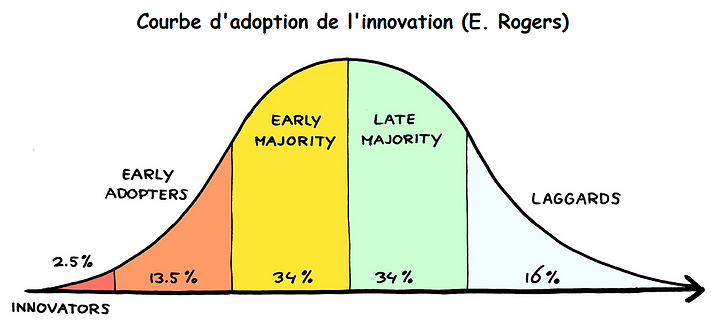By Laurent Speyser.
The adoption of Agile by organizations is a complex project often driven in a traditional way, leading these initiatives to failure. Here are 5 common traps almost all Agile transformations fall into, and some alternative ways to avoid them.
Most Agile transformations fall into the trap of having an “Agile transformation program“. Typically, this program states:
This approach is meant to be lenient with Management who are comforted in their belief in traditional change management (cascading, industrial). It is falsely reassuring, and maintains the illusion of control, by making people believe 1) that the target is the right one – because it has worked elsewhere or simply because it is fashionable 2) that strict adherence to the plan guarantees that the target will be reached.
That’s why this approach is so often sold by Agile business consultants, who are essentially pursuing commercial profits.

From then on, the focus is on following the plan, with the belief that everything will happen in a linear, sequential, and controlled way. We persevere in a predictive planning of the change, unsuited to the complexity inherent to such a transformation, and without considering feedback (the “response” to change). An illusion of agility and a huge incongruence for an “Agile” transformation! This illusion, which can last for years sometimes, finally gives way to disenchantment and leaves the organization disappointed with its true achievements… (see also The illusion of agility)
Many companies are now undergoing an Agile Transformation. But organizations are tired of change programs that follow one another, creating at least as much harm as good. People are put in a situation of repeated psychological insecurity where the feeling of fear predominates. Thus, the simple word “Transformation”, synonymous with “big bang”, immediately leads to the initiative being perceived negatively.
We believe that the main challenge of organisational change is learning. For this to happen, courageous discussions should be held with management in order to become aware of the uncertainty and complexity inherent in this type of change. We can dream big, and start with small steps, with the objective of simplifying daily work and giving it more meaning. Let’s go back to the essence of Agile: learning and adapting to discover better ways of working.
Most of Agile transformations also fall into the trap of focusing on teams first, in order to do more and more.
More productivity, more delivery, faster, etc… and what is measured? The number of lines of code written, the number of code changes (commit), the number of story points finished each sprint (aka velocity), … and – moreover — it’s used to compare teams! These metrics do not illustrate any performance. Worse, they nurture unhealthy “games”. They are generally meaningless and lead to counter-productive behaviors!
It often happens like this: first, measure and analyze the “Agile maturity” (but what does that mean???) of the teams. Then, impose a series of “best” practices to adopt. Finally, measure Agile the rate of adoption of practices rather than the benefits of using these practices.
But does it simplify the work? Does it make work more meaningful?
Each team is unique and evolves in its own context. There are no “best” practices, only practices that are good in a given context.
We believe that “better” is more important than “more”. Simplifying work, streamlining processes, limiting bureaucratic entropy (+5-7% every year!), continuously improving, bringing out good practices … while focusing on delivering the right thing. This is what “working better” could be. That is why the support of managers and leaders of the organization is essential and a priority!
Companies are evolving in an increasingly complex, fast-paced and uncertain world. They feel a real need to transform themselves quickly but without really knowing how or for what purpose.
They therefore often carry out “Agile” transformations by following market trends, by copying the models implemented by companies that have a priori been successful, while maintaining a traditional approach to change. In particular by mandating Agile.

Have you ever heard about resistance to change? Rather than it, resistance to being changed? It is counterproductive to force people to be Agile (or do Agile). A good start for Agile adoption is to invite people who are motivated by this change. That’s how you give yourself a chance to get the first real small successes. With those who will identify themselves as the “innovators” and “early adapters” of this change. The pollination of the learnings will then allow to reach the “early majority”…
We believe that inviting to change makes iteasier to take the first small steps towards sustainable and genuine change. It is therefore essential that the organization’s leaders progressively become the hosts of change, based on invitation.
it turns out that nobody wants Agile! Nobody wants Lean! Nobody wants DevOps or digital! What everybody wants are the potential benefits that come with it.
We believe that Agile should be used to sustain the organization’s goals (including its performance) by making changes that are aligned with its needs. The organization’s leaders should first be able to define the performance or improvement they are looking for, and thus be able to invite the organization to take the first small steps towards a meaningful change.
Most Agile transformations fall into the trap of deploying a single solution… “one size fits all”!
Organizational models of companies are replicated without reflecting a lot; “If it works for them, why not for us?” But it’s not so much the “model” that matters, but the way these companies got there… Instead of copying the result, the structure, we should be inspired by the culture of these organizations.
Companies willing to change are also prey to the ever-growing Agile marketing and business, to the commercial war of the “frameworks” (especially at scale!) and their respective gurus, to their race to popularity…
We believe that there is no silver bullet. Every organization, team, individual is unique. For each situation, it is necessary to first design experiments that promote awareness. Then to help the experts of the context and the organization to bring out thier own solutions through experiments, to make the situation evolve towards the desired future.
At SoKube, we believe that it is essential to support the organization’s leaders to avoid these traps, to be aware of the risks involved, and to adopt new stances that would allow to: